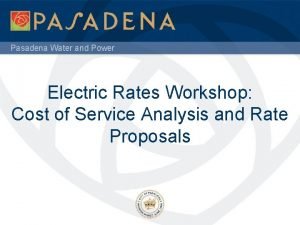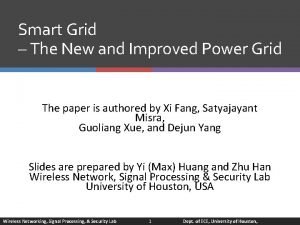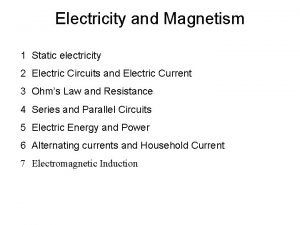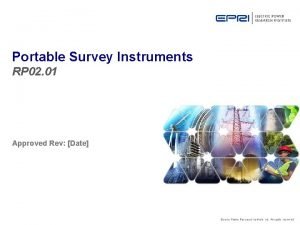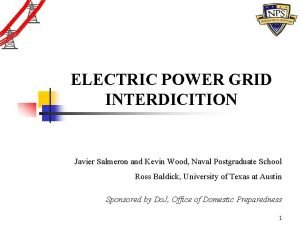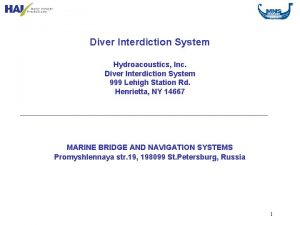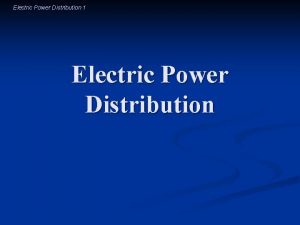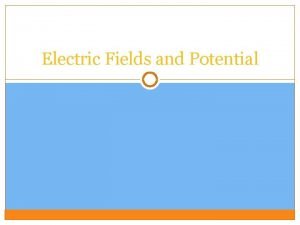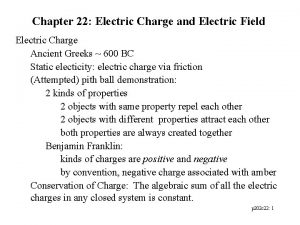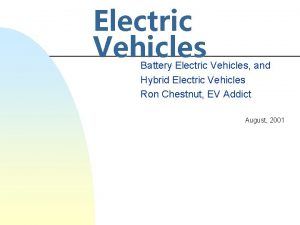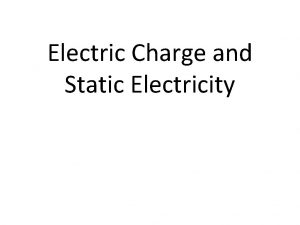ELECTRIC POWER GRID INTERDICTION Javier Salmeron and Kevin





















- Slides: 21

ELECTRIC POWER GRID INTERDICTION Javier Salmeron and Kevin Wood, Naval Postgraduate School Ross Baldick, University of Texas at Austin Sponsored in part by Department of Homeland Security, Office of Domestic Preparedness 1

What is VEGA? VEGA is a tool for analyzing the vulnerability and defense of electric power systems under threats posed by terrorist attacks. • VEGA determines the worst possible disruption that could be caused by a terrorist attack, • Compares multiple attack plans terrorists might undertake under different resource-constrained assumptions, • Assesses security enhancement through preemptive measures, and • VEGA is based on powerful optimization techniques. 2

Vulnerability of Electric Power Grids: A Long-Recognized Issue Ø“One can hardly imagine a target more ideal than the U. S. domestic energy” (A. B. and L. H. Lovins, 1983) Ø“Any U. S. region could suffer lasting and widespread blackouts if three or more substations were targeted. ” (OTA, 1990) Ø “The U. S. is at, or is fast approaching, a crisis stage with respect to reliability of transmission grids. ” (NERC, 2001) Ø “The U. S. electric power systems must clearly be made more resilient to terrorist attack. ” (Committee on Science and Technology for Countering Terrorism, NRC, 2002) 3

Terrorist Threat? Ø “And the threat isn't simply academic. U. S. occupation forces in Afghanistan discovered Al Qaeda documentation about the facility that controls power distribution for the eastern U. S. , fueling fears that an attack on the power grid may one day become a reality. ” (Energy Pulse, 2003) Ø(On Ahmed Ressam) “They were specifically trained to attack critical infrastructure, including electric power plants. ” (CNN, 2002) Ø(On Colombian FARC) “They are leaving entire regions without service. We can’t post a soldier at every tower” (ISA spokesman, 2002) 4

Terrorist Threat? (cont. ) Potential targets: Ø Generating plants ØTransmission and distribution lines Ø Substations Easy disruption + Widespread damage + Difficult recovery 5

Modeling Assumptions • U. S. systems are operated so that a single failure does not disrupt the system (N– 1 security) • We investigate vulnerability to multiple, coordinated failures (N–m). • Our approach uses optimization theory to: - Mathematically represent a power grid and power flows - Identify worst-case attacks to the grid (most “disruptive”) - Provide insight into physical vulnerabilities, and help guide protective plans that will mitigate disruptions should attacks occur (We maintain the assumption of information transparency) 6

Key Questions What are the best - New investments (e. g. , new facilities, lines, spare transformers) - Upgrades (e. g. , replacing conductors) - Protective measures (e. g. , hardening, surveillance. . . ) in - Generating systems and/or - Transmission and distribution systems that substantially reduce system vulnerabilities? “Best”= Improve Security + Affordable (+ Market Benefits? ? ? ) 7

Mathematical Analysis Ø To defend an electric grid, first learn how to attack it! - Optimal power flow model (minimize load shedding) - Interdiction model (maximize disruption, i. e. , load shedding) Ø Additional features of the problem are: - Time scale: Very short-, medium- and long-term - Customer types; ability to “share the pain” - Uncertainty about terrorist resources - (Protective measures? ? ? ) 8

Integrating Three Levels of Optimization - Level 1: Optimal power flow model to minimize “disruption”: (disruption = load shedding + increased costs) Data: Power grid data - Level 2: Interdiction model to maximize “Level-1 disruption” Data: Power grid data and terrorist resources - Level 3: Protective model to minimize “Level-2 interdiction” Data: Power grid data, terrorist resource and counterterrorist resources (budget for expansion, spares, upgrades, hardening) (See mathematical details at the end of this presentation) 9

Other Factors: System Restoration, Demand Curves. . . Grid Component Interdictable Resources (number of terrorists) Outage Duration (h) Lines (AC/DC) (overhead) YES 1 72 (or 48) Lines (underground) NO N/A Transformers YES 2 768 (or 168) Buses YES 3 (or 2) 360 (or 168) Generators NO N/A Substations YES 3 768 (or 360) MW shedding No Repair Lines Trafos with Spares (Attack) One to several days Days to one week Slow repair Weeks (months) 10 t

IEEE Reliability Test System 96 -99 BUS 18 BUS 17 Total Load: 2, 850 MW C BUS 21 BUS 22 BUS 23 A G BUS 16 230 k. V A A D B A A BUS 19 C B BUS 20 BUS 14 Synch. Cond. A BUS 13 BUS 15 E B B C BUS 11 BUS 24 BUS 12 B BUS 3 BUS 9 C A BUS 10 BUS 6 cable BUS 4 F MW BUS 5 138 k. V A B Attack +72 h C B +360 h BUS 8 A cable BUS 7 +768 h t BUS 1 BUS 2 Salmeron, Wood and Baldick (2004), IEEE Transactions on Power Systems 11

VEGA: Vulnerability of Electric Power Grids Analyzer Potential Users: Ø Utilities, ISOs. . . Ø Government analysts 12

VEGA: Main Menu • File mgmt. • Grid data • Optimization • Results • One-Line GUI • Help 13

Power Grid Data 14

One-Line GUI: Power Flow After Optimal Interdiction 15

Power Flow Model (DC Approx. ) DC-OPF: s. t. i: bus, l: line, g: generator, PLine, PGen: power (MW) c: customer sector S: power shed : bus phase 16

Interdiction Model I-DC-OPF: s. t. Interdiction max-min problem I-DC-OPF: Can be converted into a standard mixed-integer model 17

Interdiction Model Heuristic Solve the DC-OPF Power Flow Model given the current grid configuration ( ) Interdict the assets that maximize “Total Value” Based on present and previous flow patterns, assign a “Value” (V) to each interdictable asset 18

Exact (Mixed-Integer) Linearization of I-DC-OPF 19

Results for the Linearized MIP Case/Algorithm Directly Interdicted Components RTS-Two. Areas (M=12) HEURISTIC Substations: Sub-A 1, Sub-A 2, Sub-B 1, Sub. B 2 RTS-Two. Areas (M=12) MIP Lines: A 23, B 23 Transformers: A 7, B 7 Substations: Sub-A 2, Sub-B 2 Case/Algorithm Directly Interdicted Components RTS-Two-Areas (M=24) HEURISTIC RTS-Two-Areas (M=24) MIP Buses: 116, 118, 215, 218 Substations: Sub-A 1, Sub-A 2, Sub-B 1, Sub. B 2 Lines: A 30, A 33 -2 Transformers: A 7, B 7 Buses: 115, 118, 215, 218 Substations: Sub-A 2, Sub-B 2 Time Period Power Shed (MW) Energy Shed (MWh) 0 -768 1, 416 1, 087, 488 Total: 1, 087, 488 0 -72 h 1, 804 129, 888 72 -768 h 1, 416 985, 536 Total: 1, 115, 424 Time Period Power Shed (MW) Energy Shed (MWh) 0 -360 h 2, 693 969, 480 360 -768 h 1, 416 577, 728 Total: 1, 547, 208 0 -72 h 3, 164 227, 808 72 -360 h 2, 716 782, 208 360 -720 h 1, 416 577, 728 Total: 1, 587, 744 20

The VEGA Team Javier Salmeron, NPS jsalmero@nps. edu Kevin Wood, NPS kwood@nps. edu Ross Baldick, UT Austin baldick@ece. utexas. edu 21
 Land grid array vs pin grid array
Land grid array vs pin grid array What is this area
What is this area Electric field from electric potential
Electric field from electric potential Electric potential of dipole
Electric potential of dipole Chapter 21 electric charge and electric field
Chapter 21 electric charge and electric field Chapter 21 electric charge and electric field
Chapter 21 electric charge and electric field Unit of charge
Unit of charge Units of a charge
Units of a charge Electric charges and electric forces lesson outline
Electric charges and electric forces lesson outline Ac power formula
Ac power formula Electric potential
Electric potential A suitable electric pump in an electric circuit is a
A suitable electric pump in an electric circuit is a Pasadena water and power rates
Pasadena water and power rates Types of circuits and ohm's law worksheet answers
Types of circuits and ohm's law worksheet answers Ondej
Ondej Improved power grid
Improved power grid Stakeholder mapping
Stakeholder mapping Electric power equation
Electric power equation Electric power equation
Electric power equation Electric power research institute
Electric power research institute Nei electric power engineering
Nei electric power engineering Javier arvalo
Javier arvalo












